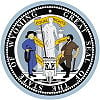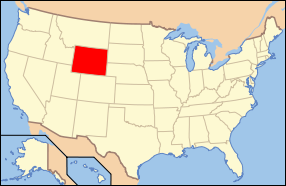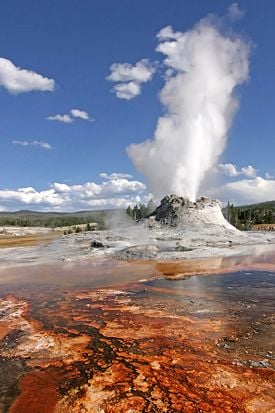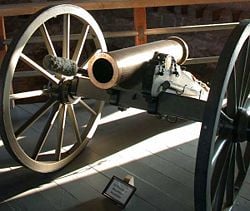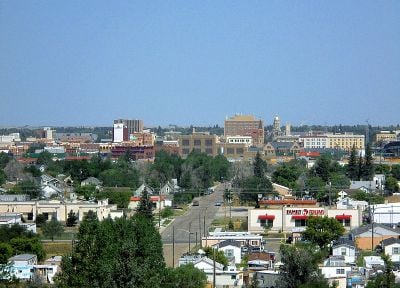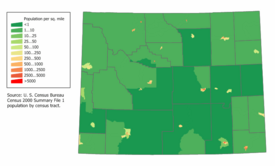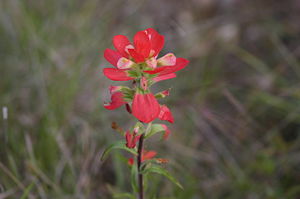Wyoming
| State of Wyoming | |||||||||||
| |||||||||||
| Official language(s) | English | ||||||||||
| Capital | Cheyenne | ||||||||||
| Largest city | capital | ||||||||||
| Largest metro area | Cheyenne Metro Area | ||||||||||
| Area | Ranked 10th | ||||||||||
| - Total | 97,814 sq mi (253,348 km²) | ||||||||||
| - Width | 280 miles (450 km) | ||||||||||
| - Length | 360 miles (581 km) | ||||||||||
| - % water | 0.7 | ||||||||||
| - Latitude | 41°N to 45°N | ||||||||||
| - Longitude | 104°3'W to 111°3'W | ||||||||||
| Population | Ranked 50th in the U.S. | ||||||||||
| - Total | 568,158 (2011 estimate)[1] | ||||||||||
| - Density | 5.85/sq mi (2.26/km2) Ranked 49th in the U.S. | ||||||||||
| Elevation | |||||||||||
| - Highest point | Gannett Peak[2][3] 13,809 ft (4209.1 m) | ||||||||||
| - Mean | 6,700 ft (2040 m) | ||||||||||
| - Lowest point | Belle Fourche River at South Dakota border[2][3] 3,101 ft (945 m) | ||||||||||
| Admission to Union | July 10, 1890 (44th) | ||||||||||
| Governor | Matt Mead (R) | ||||||||||
| Lieutenant Governor | Max Maxfield (R) | ||||||||||
| U.S. Senators | Mike Enzi (R) John Barrasso (R) | ||||||||||
| Time zone | Mountain: UTC-7/-6 | ||||||||||
| Abbreviations | WY US-WY | ||||||||||
| Web site | wyoming.gov | ||||||||||
The State of Wyoming is a state in the western region of the United States of America. The majority of the state is dominated by the mountain ranges and rangelands of the Rocky Mountain West, while the easternmost section of the state is a high altitude prairie region known as the High Plains. Within the boundaries of the "Cowboy State" is the first and largest National Park in the United States, Yellowstone, and Devil's Tower the first National Monument (1906).
Wyoming has the distinction of being a state that provided several firsts for the advancement of American women, and is known as the "Equality State" because of it. Wyoming women were the first in the nation to vote, serve on juries and hold public office, long before other states followed suit. [4]
While it is the tenth largest U.S. state by size, Wyoming is the least populous with an U.S. Census estimated population of 515,004 in 2006, a 4.3 percent increase since 2000.[5]The capital and the most populous city of Wyoming is Cheyenne. Residents of Wyoming are known as Wyomingites.
Wyoming is predominantly conservative and politically Republican. The state has not voted for a Democrat for president since 1964.
Etymology
The name Wyoming is derived from the Delaware (Munsee) name xwé:wamənk, meaning at the big river flat, originally applied to the Wyoming Valley in Pennsylvania.[6]Wyoming is nicknamed the "cowboy state" because of its pre-statehood economy which consisted mainly of cattle and sheep ranching.
Geography
Location and Size
Wyoming is bordered on the north by Montana, on the east by South Dakota and Nebraska, on the south by Colorado, on the southwest by Utah, and on the west by Idaho. It is the tenth largest state in the United States in total area, containing 97,818 square miles (253,348 km²) and is made up of 23 counties. From the north border to the south border it is 276 miles (444 km); and from the east to the west border is 375 miles (603 km).
Mountain ranges
The Great Plains meet the Rocky Mountains in Wyoming. The state is a great plateau broken by a number of mountain ranges. Surface elevations range from the summit of Gannett Peak in the Wind River Mountain Range, at 13,804 feet (4,207 m), to the Belle Fourche River Valley in the state’s northeast corner, at 3,125 feet (952 m). In the northwest are the Absaroka, Owl Creek, Gros Ventre, Wind River and the Teton ranges. In the north central are the Big Horn Mountains; in the northeast, the Black Hills; and in the southern region the Laramie, Snowy and Sierra Madre ranges.
Wyoming is an arid state with much of the land receiving less than 10 inches (25 cm) of rainfall per year. Consequently, the land supports few opportunities for farming. Ranching is widespread, especially in areas near the numerous mountain chains. The Snowy Range in the south central part of the state is an extension of the Colorado Rockies in both geology and appearance. The Wind River Range in the west central part of the state is remote and includes more than 40 mountain peaks in excess of 13,000 ft. tall in addition to Gannett Peak, the highest peak in the state. The Big Horn Mountains in the north central portion are somewhat isolated from the bulk of the Rocky Mountains.
The Teton Range in the northwest extends for 50 miles (80 km) and represents the most impressive section of mountains in the state. It is home to Grand Teton, the second highest peak in Wyoming, and to Grand Teton National Park, which preserves the most scenic section of the Teton range.
The Continental Divide spans north-south across the central portion of the state. Rivers east of the Divide drain into the Missouri River Basin and eventually the Atlantic Ocean. They are the Platte, Wind, Big Horn and the Yellowstone rivers. The Snake River in northwest Wyoming eventually drains into the Columbia River and the Pacific Ocean, as does the Green River through the Colorado River Basin.
The Continental Divide forks in the south central part of the state in an area known as the Great Divide Basin where the waters that flow or precipitate into this area remain there and cannot flow to any ocean. Instead, because of the overall aridity of Wyoming, water in the Great Divide Basin simply sinks into the soil or evaporates.
Several rivers begin or flow through the state, including the Yellowstone River, Powder River, Green River, and the Snake River.
Climate
The climate in Wyoming is generally a semi-arid continental climate (Koppen climate classification BSk) which is drier and windier in comparison to most of the United States with temperature extremes. Much of this is due to the topography of the state. Summers in Wyoming are warm with July high temperatures averaging between 85 °F (29°C) and 95 °F (35°C) in most of the state. With increasing elevation, however, this average drops rapidly with locations above 9,000 feet (2,743 m) averaging around 70 °F (21°C). Summer nights throughout the state are characterized by a rapid cooldown with even the hottest locations averaging in the 50-60 °F (10-14 °C) range at night. In most of the state, the late spring and early summer is when most of the precipitation tends to fall. Winters are cold, but are variable with periods of sometimes extreme cold interspersed between generally mild periods, with Chinook winds providing unusually warm temperatures in some locations. Precipitation depends on elevation with lower areas in the Big Horn Basin averaging 5-8 inches (125 - 200 mm) (making the area nearly a true desert). The lower areas in the North and on the eastern plains typically average around 10-12 inches (250-300 mm), making the climate there semi-arid. Some mountain areas do receive a good amount of precipitation, 20 inches (510 mm) or more, much of it as snow, sometimes 200 inches (510 cm) or more annually.
The climate of any area in Wyoming is largely determined by its latitude, altitude and local topography. When put together, these factors have a lot to do with airflow patterns, temperature variations, precipitation and humidity brought in by the weather systems that migrate eastward. In winter, Wyoming is often beneath the jet stream, or north of it, which accounts for its frequent strong winds, blasts of Arctic air and precipitation, all the necessary ingredients for great snow conditions at Wyoming's northwestern ski areas. In summer, the jet stream retreats northward to somewhere over Canada, leaving the state's weather mild and pleasant at a time when the majority of Wyoming's visitors choose to arrive. Jackson, located at 6,230 feet (1,899 m) above sea level and surrounded by mountains, can expect a high temperature in July of 80˚ F (26.6°C). The average is more likely to be 65˚ F (18.3°C). The closest National Weather Station (in Riverton on the other side of the Wind River Mountains at 4,955 feet (1,510 m)) reports slightly warmer July weather.
Weather and topography in Wyoming both have more contrast than in most other states. Severe weather is not uncommon in Wyoming, with the state being one of the leading states for hail damage in the United States. The number of thunderstorm days vary across the state with the southeastern plains of the state having the most days of thunderstorm activity. Thunderstorm activity in the state is highest during the late spring and early summer. The southeastern corner of the state is the most vulnerable part of the state to tornado activity. Moving away from that point and westwards, the incidence of tornadoes drops dramatically with the west part of the state showing little vulnerability. Tornadoes, where they occur, tend to be small and brief, unlike some of those which occur a little further east.
History
The region known today as the state of Wyoming was originally inhabited by several Native American groups. The Crow, Arapaho, Lakota, and Shoshone were but a few of the original inhabitants encountered when white explorers first entered the region. Although French trappers may have ventured into the northern sections of the state in the late 1700s, John Colter, a member of the Lewis and Clark Expedition, was probably the first white American to enter the region in 1807. His reports of the Yellowstone area were considered at the time to be fictional. Robert Stuart and a party of five men returning from Astoria discovered South Pass in 1812. The route was later followed by the Oregon Trail. In 1850, Jim Bridger located what is now known as Bridger Pass, which was later used by both the Union Pacific Railroad in 1868, and in the 20th century by Interstate 80. Bridger also explored the Yellowstone region and like Colter, most of his reports on that region of the state were considered at the time to be tall tales.
After the Union Pacific Railroad reached the town of Cheyenne, which later became the state capital, in 1867, the population began to grow steadily in the Wyoming Territory, which was established on July 25, 1868.[7] Unlike Colorado to the south, Wyoming never experienced a rapid population boom from any major mineral discoveries such as gold or silver. Copper was found in some areas of the state.
Once government sponsored expeditions to the Yellowstone country were undertaken, the previous reports by men like Colter and Bridger were found to be true. This led to the creation of Yellowstone National Park, which became the world's first National Park in 1872. It is located in the far northwestern portion of the state. Most of the territory that comprises Yellowstone National Park is located in Wyoming.
Wyoming was admitted to the Union on July 10, 1890. It was named after the Wyoming Valley of Pennsylvania, made famous by the 1809 poem Gertrude of Wyoming by Thomas Campbell. The name was suggested by Representative J. M. Ashley of Ohio.
In 1869, Wyoming extended suffrage to women, partly in an attempt to garner enough votes to be admitted as a state. In addition to being the first U.S. state to extend suffrage to women, Wyoming was also the home of many other firsts for U.S. women in politics. For the first time, women served on a jury in Wyoming (Laramie in 1870). Wyoming had the first female court bailiff (Mary Atkinson, Laramie, in 1870) and the first female justice of the peace in the country (Esther Hobart Morris, South Pass City, in 1870). Wyoming became the first state in the Union to elect a female governor, Nellie Tayloe Ross, who was elected in 1924 and took office in January 1925.
Wyoming was the location of the Johnson County War of 1892 which was fought between large cattle operators and new homesteaders. This war was fought because of the new ranchers moving in following the passage of the Homestead Act. The Homestead Act gave pioneers of the frontier a special opportunity to own their own land for the sake of farming or ranching. The creation of new homesteads did not sit well with established ranchers who, until the passing of the Homestead Act, had free access to the open ranges for grazing animals.
During World War II Wyoming was one of several states where Japanese Americans were incarcerated in internment camps. Heart Mountain Relocation Center in Wyoming was located between the towns of Cody and Powell.
The story of boom and bust has gone on in the energy and mining industries in Wyoming for much of the twentieth century. Wyoming has had a rather quiet profile since its colorful and exciting past of its former frontier days. Today Wyoming is known for its scenic locations which attract millions of tourists each year. Cowboy lore is not just a myth of the past but endures through the everyday culture of life on the range where antelope still roam.
Law and government
Cheyenne is the capital of Wyoming and the seat of Laramie County. It is the state's oldest city and also its largest. Established on July 4, 1867 the name Cheyenne means "aliens" or "people of foreign language." The Sioux Indians gave this name to the Indian tribe "Dzitsistes," who roamed the open plains. Their spelling was Shyenne.
Cheyenne is located near the geographical and time center of North America. As of September 2005, it had an estimated population of 55,362. Strategically situated at a major transportation hub (the intersection of Interstates 25 and 80 and two major railroads), it is a developing center of commerce. Only 90 minutes north of Denver, Colorado, Cheyenne sits as the northern anchor city of the Front Range of the Rocky Mountains.
The magazine True West recognized Cheyenne as the nation's No. 5 True Western Town in its January/February 2007 issue. Since 1897 Cheyenne has hosted "Frontier Days," the world's largest outdoor rodeo and western celebration. The ten-day event is known internationally for its authentic trip back in time.[8]
Wyoming law establishes three branches of government: executive, legislative, and judicial branches.
It has a House of Representatives with 60 members and a Senate with 30 members.
Because of its low population, Wyoming only has three votes in the electoral college. It is also due to this low population that individuals in Wyoming technically have a more powerful vote in presidential elections than anyone else in the United States. For example, while Montana had a 2000 census population of 902,195 to Wyoming's 493,782, they both have the same number of electoral votes.
Judicial System
Wyoming's highest court is the Supreme Court of Wyoming, with five justices presiding over appeals from the state's lower courts. Wyoming is unique in that it does not have an intermediate appellate court, like most states. This is largely attributable to the state's size and correspondingly lower caseload. Appeals from the state district courts go directly to the Wyoming Supreme Court. Wyoming also has state circuit courts (formerly county courts), of limited jurisdiction, which handle certain types of cases, such as civil claims with lower dollar amounts, misdemeanor criminal offenses, and felony arraignments. Circuit court judges also commonly hear small claims cases as well. All state court judges in Wyoming are nominated by the Judicial Nominating Commission and appointed by the Governor. They are then subject to a retention vote by the electorate.
Politics
Wyoming is predominantly conservative and politically Republican. The state has not voted for a Democrat for president since 1964, and there are only two consistently Democratic counties. In the 2004 presidential election, George W. Bush won his second-largest victory, with 69 percent of the vote. Bush's Vice President, Dick Cheney, is a Wyoming resident and represented the state in Congress from 1979 to 1989. However, after his term, he resided primarily in Texas, a fact that drew mild criticism from his political opponents when he changed his voter registration back to Wyoming prior to joining George W. Bush's ticket in the 2000 Presidential election.
Despite Wyoming's clear preference for Republicans in national offices, Democrats have held the governorship for all but eight years since 1975. Governor Dave Freudenthal was elected in 2002 and has one of the highest approval ratings of any governor in the U.S. Wyoming in 2006 reelected incumbent Republican Congresswoman Barbara Cubin by just over 1,200 votes.
Economy
According to the 2005 U.S. Bureau of Economic Analysis report, Wyoming’s gross state product was $27.4 billion. Wyoming’s unemployment rate for 2006 was approximately 3.3 percent, which is lower than the national average of 4.6 percent. Components of Wyoming's economy differ significantly from those of other states. The mineral extraction industry and the travel and tourism sector are the main drivers behind Wyoming’s economy. The Federal government owns 50 percent of its landmass, while 6 percent is controlled by the state. Total taxable values of mining production in Wyoming for 2001 was over $6.7 billion. The tourism industry accounts for over $2 billion in revenue for the state.
In 2002, over six million people visited Wyoming’s National Parks and monuments. The key tourist attractions in Wyoming include Grand Teton National Park, Yellowstone National Park, Devil’s Tower National Monument, and Fossil Butte National Monument. Each year Yellowstone National Park receives three million visitors.
Historically, agriculture has been an important component of Wyoming’s economic identity. Its overall importance to the performance of Wyoming’s economy has waned. However, it is still an essential part of Wyoming’s culture and lifestyle. The main agricultural commodities produced in Wyoming include livestock (beef), hay, sugar beets, grain (wheat and barley), and wool. Over 91 percent of land in Wyoming is classified as rural.
Mineral production
Wyoming’s mineral commodities include coal, natural gas, coalbed methane, crude oil, uranium, and trona. Wyoming ranks highest in mining employment in the U.S. In fiscal year 2002, Wyoming collected over $48 million in sales taxes from the mining industry.
- Coal: Wyoming produced 395.5 million short tons (358.8 metric tons) of coal in 2004. The state is the number one producer of coal in the U.S.[9] Wyoming possesses a reserve of 68.7 billion tons (62.3 billion metric tons) of coal. Major coal areas include the Powder River Basin and the Green River Basin
- Natural Gas: In 2004, natural gas production was 1,929 billion cubic feet (54.6 billion m3). Wyoming ranks 5th nationwide for natural gas production. The major markets for natural gas include industrial, commercial, and domestic heating.
- Coal Bed Methane (CBM): The boom for CBM began in the mid-1990s. CBM is characterized as methane gas that is extracted from Wyoming’s coal bed seams. It is another means of natural gas production. There has been substantial CBM production the Powder River Basin. In 2002, the CBM production yield was 327.5 billion cubic feet (9.3 billion m3).
- Crude Oil: Production of Wyoming crude oil in 2004 was 51.7 million barrels. The state is ranked 7th among producers of oil in the U.S. Petroleum is most often used as a motor fuel, but it is also utilized in the manufacture of plastics paints, and synthetic rubber.
- Trona: Wyoming possesses the largest known reserve of trona in the world. Trona is used for manufacturing glass, paper, soaps, baking soda, water softeners, and pharmaceuticals. In 2002 Wyoming produced 17.3 million short tons (15.7 million metric tons) of trona.
- Uranium: Although uranium mining in Wyoming is much less active than it was in previous decades, recent increases in the price of uranium have generated new interest in uranium prospecting and mining.
Taxes
Unlike most other states, Wyoming does not levy an individual or corporate income tax. In addition, Wyoming does not assess any tax on retirement income earned and received from another state. Wyoming has a state sales tax of 4 percent. Counties have the option of collecting an additional 1 percent tax for general revenue and a 2 percent tax for specific purposes, if approved by voters. There also is a county lodging tax that varies from 2 percent to 5 percent. The state collects a use tax of 5 percent on items purchased elsewhere and brought into Wyoming.
All property tax is based on the assessed value of the property and Wyoming's Department of Revenue's Ad Valorem Tax Division supports, trains, and guides local government agencies in the uniform assessment, valuation and taxation of locally assessed property. "Assessed value" means taxable value; "taxable value" means a percent of the fair market value of property in a particular class. Statutes limit property tax increases. For county revenue, the property tax rate cannot exceed 12 mills (or 1.2 percent) of assessed value. For cities and towns, the rate is limited to 8 mills (0.8 percent). With very few exceptions, state law limits the property tax rate for all governmental purposes.
Personal property held for personal use is tax-exempt. Inventory if held for resale, pollution control equipment, cash, accounts receivable, stocks and bonds are also exempt. Other exemptions include property used for religious, educational, charitable, fraternal, benevolent and government purposes and improvements for handicapped access. Minerals are exempt from property tax but companies must pay a gross products tax and a severance tax when produced. Underground mining equipment is tax exempt.
Wyoming does not collect inheritance taxes. Because of the phase-out of the federal estate tax credit, Wyoming's estate tax is not imposed on estates of persons who died in 2005. There is limited estate tax related to federal estate tax collection.
Transportation
Though Wyoming itself is sparsely populated, its geographical location as a crossroads between major markets, such as Salt Lake City, Utah and Denver, Colorado, necessitates a quality interstate system. Its long stretches of open highway lead a traveller through stunning terrain and wide-open skies.
Three interstate highways and seven U.S. highways pass through Wyoming. In addition, the state is served by the state highway system. Interstate 25 runs north and south from Montana to Colorado through the state's largest cities, Cheyenne and Casper. East to west, Interstate 80 passes through the cities of Cheyenne, Laramie, Rawlins, Rock Springs, Green River and Evanston before it exits Wyoming toward Salt Lake City, Utah. In the northern section of the state, through the towns of Sheridan and Gillette, runs Interstate 90, connecting to the northern states.
The U.S. highways that pass through the state are:
- U.S. Route 14
- U.S. Route 16
- U.S. Route 20
- U.S. Route 30
- U.S. Route 26
- U.S. Route 89
- U.S. Route 191
- U.S. Route 287
There are 36 public airports in the state, including 10 commercial service airports. These all connect to either Salt Lake City or Denver. The Union Pacific and Burlington Northern Santa Fe railroads have lines crisscrossing the state. [10]
Education
Public education is directed by the State Superintendent of Public Instruction, an elected state official. Educational policies are set by the State Board of Education, a nine-member board appointed by the governor. The constitution prohibits the state from establishing curriculum and text book selections; these are the prerogatives of local school boards.
The Wyoming School for the Deaf in Casper, operated by the State Department of Education, serves approximately 44 students either at the Deaf School or in public schools of the state. Many students attending the school in Casper are residents of other communities who are housed in private residences in Casper during the school year.
There are seven junior or community colleges throughout the state. Wyoming is also notable as being the only state in the U.S to have only one four-year college, the University of Wyoming until the Wyoming Catholic College was founded in 2007 in Lander. Wyoming Catholic College is still in the midst of the accreditation process.
Demographics
Population
The center of population of Wyoming is located in Natrona County. [11]
As of 2005, Wyoming has an estimated population of 509,294, which is an increase of 3,407, or 0.7 percent, from the prior year and an increase of 15,512, or 3.1 percent, since the 2000 census. This includes a natural increase since the last census of 12,165 people (that is 33,704 births minus 21,539 deaths) and an increase from net migration of 4,035 people into the state. Immigration from outside the United States resulted in a net increase of 2,264 people, and migration within the country produced a net increase of 1,771 people. In 2004, the foreign-born population was 11,000 (2.2 percent). In 2005, total births in Wyoming numbered 7,231 (Birth Rate of 14.04). [12]
Wyoming is the least populous of any state (or the District of Columbia) and has the lowest population density of the 48 states. (Alaska's population density is lower although its total population is higher).
The largest ancestry groups in Wyoming are: German (25.9 percent), English (15.9 percent), Irish (13.3 percent), American (6.5 percent), Norwegian (4.3 percent), Swedish (3.5 percent)
Religion
The religious affiliations of the people of Wyoming are shown in the table below:
- Christian – 78 percent
- Protestant – 53 percent
- Lutheran – 8 percent
- Baptist – 8 percent
- Methodist – 6 percent
- Presbyterian – 4 percent
- Episcopal – 4 percent
- Other Protestant or general Protestant – 21 percent
- Roman Catholic – 16 percent
- LDS (Mormon) – 11 percent
- Protestant – 53 percent
- Other Religions – 1 percent
- Jewish – 0.1 percent
- Non-Religious – 20.9 percent
Metropolitan areas
The United States Census Bureau has defined two Metropolitan Statistical Areas and seven Micropolitan Statistical Areas for the State of Wyoming.
In 2005, 50.6 percent of Wyomingites lived in one of the 13 most populous Wyoming municipalities, while 30.4 percent of the population lived in either of the Metropolitan Statistical Areas, and 73 percent lived in either a Metropolitan Statistical Area or a Micropolitan Statistical Area.
| Census Area | County | Population |
|---|---|---|
| Cheyenne, WY, Metropolitan Statistical Area | Laramie County, Wyoming | 85,163 |
| Casper, WY, Metropolitan Statistical Area | Natrona County, Wyoming | 69,799 |
| Rock Springs, WY, Micropolitan Statistical Area | Sweetwater County, Wyoming | 37,975 |
| Gillette, WY, Micropolitan Statistical Area | Campbell County, Wyoming | 37,405 |
| Riverton, WY, Micropolitan Statistical Area | Fremont County, Wyoming | 36,491 |
| Laramie, WY, Micropolitan Statistical Area | Albany County, Wyoming | 30,890 |
| Sheridan, WY, Micropolitan Statistical Area | Sheridan County, Wyoming | 27,389 |
| Jackson, WY-ID, Micropolitan Statistical Area | Teton County, Wyoming | 19,032 |
| Teton County, Idaho | 7,467 | |
| Total | 26,499 | |
| Evanston, WY, Micropolitan Statistical Area | Uinta County, Wyoming | 19,939 |
Miscellaneous information
- USS Wyoming was named in honor of this state.
| Wyoming State Symbols |
|
Areas in Wyoming under the management of the National Park Service include:
- Bighorn Canyon National Recreation Area in the northern part of the state
- California National Historic Trail
- Devils Tower National Monument near Devils Tower, Wyoming
- Fort Laramie National Historic Site in southeast Wyoming
- Fossil Butte National Monument at Kemmerer
- Grand Teton National Park near Moose, Wyoming
- John D. Rockefeller, Jr. Memorial Parkway near Moose
- Mormon Pioneer National Historic Trail
- Oregon National Historic Trail
- Pony Express National Historic Trail
- Yellowstone National Park
Notable residents
A few Wyomingites of note are: "Buffalo" Bill Cody, Martha Canary (Calamity Jane), Nellie Tayloe Ross (first woman U.S. state Governor) Esther Hobart Morris (first woman Judge), business man J. C. Penney, U.S. senator Alan Simpson, actor Harrison Ford, and country music singer Chris Ledoux.
- View of the Teton Range looking west from Jackson Hole, Wyoming, Grand Teton National Park
Notes
- ↑ Error on call to template:cite web: Parameters url and title must be specified (CSV). 2011 Population Estimates. United States Census Bureau, Population Division (December 2011).
- ↑ 2.0 2.1 Elevations and Distances in the United States. United States Geological Survey (2001). Retrieved October 24, 2011.
- ↑ 3.0 3.1 Elevation adjusted to North American Vertical Datum of 1988.
- ↑ [1] Wyoming's Equality Heritage. Wyoming.gov. Retrieved December 13, 2007.
- ↑ U.S. Census Bureau. Annual Population Estimates 2000 to 2006.
- ↑ William Bright. 2004. Native American placenames of the United States. (Norman: University of Oklahoma Press. ISBN 080613576X), 576
- ↑ General Facts About Wyoming Wyoming.gov. Retrieved December 13, 2007.
- ↑ Cheyenne is a 2007 Top True Western Town! Cheyenne.org. Retrieved December 13, 2007.
- ↑ U.S. Overview, State Energy Highlights Energy Information Administration. Retrieved February 24, 2012.
- ↑ Wyoming Business Council. Infrastructure & Transportation Retrieved December 15, 2007.
- ↑ U.S. Census Bureau. Population and Population Centers by State: 2000.
- ↑ AP May 21, 2007 Hispanics fastest growing ethnic group in Wyoming Billingsgazette.net. Retrieved December 13, 2007.
- ↑ U. S. Census Bureau. 2005 Population Estimates.
ReferencesISBN links support NWE through referral fees
- Bright, William. 2004. Native American placenames of the United States. Norman: University of Oklahoma Press. ISBN 080613576X
- Larson, T. A. 1990. History of Wyoming. Lincoln: University of Nebraska Press. ISBN 0803279361
- Roberts, Phil. 2000. Readings in Wyoming History. Laramie: Skyline West. ISBN 0914767283
- Sodaro, Craig, and Randy Adams. 1996. Frontier spirit the story of Wyoming. Boulder, CO: Johnson Book. ISBN 1555661637
- Stewart, Elinore Pruitt. 1989. Letters of a Woman Homesteader. Lincoln: University of Nebraska Press. ISBN 0803251939
- Vexler, Robert I. 1978. Chronology and Documentary Handbook of the State of Wyoming. Chronologies and documentary handbooks of the States, [49]. Dobbs Ferry, NY: Oceana Publications. ISBN 0379161893
- Writers' Program of the Work Projects Administration in the State of Wyoming. 1973. Wyoming, a guide to its history, highways, and people. St. Clair Shores, MI: Scholarly Press. ISBN 0403021995
External links
All links retrieved May 20, 2023.
- Wyoming Welcomes You State of Wyoming.
- Wyoming's portal to knowledge and learning Wyoming State Library.
- Luong, QT. Photos of Wyoming TerraGalleria.com.
- Photographs and History of Old Wyoming Wyomingtalesandtrails.com.
| State of Wyoming Cheyenne (capital) | |
| Topics | Governors |
Geography | Government | Economy | History |
| Regions | Black Hills |
Grand Teton | Great Basin | Powder River Country | Yellowstone |
|
Cities |
Casper |
Cheyenne | Cody | Evanston | Gillette | Green River | Jackson | Laramie | Rawlins | Riverton | Rock Springs | Sheridan | Worland |
| Counties | Albany |
Big Horn | Campbell | Carbon | Converse | Crook | Fremont | Goshen | Hot Springs | Johnson | Laramie | Lincoln | Natrona | Niobrara | Park | Platte | Sheridan | Sublette | Sweetwater | Teton | Uinta | Washakie | Weston |
| Political divisions of the United States | |||||||
|---|---|---|---|---|---|---|---|
| |||||||
Credits
New World Encyclopedia writers and editors rewrote and completed the Wikipedia article in accordance with New World Encyclopedia standards. This article abides by terms of the Creative Commons CC-by-sa 3.0 License (CC-by-sa), which may be used and disseminated with proper attribution. Credit is due under the terms of this license that can reference both the New World Encyclopedia contributors and the selfless volunteer contributors of the Wikimedia Foundation. To cite this article click here for a list of acceptable citing formats.The history of earlier contributions by wikipedians is accessible to researchers here:
The history of this article since it was imported to New World Encyclopedia:
Note: Some restrictions may apply to use of individual images which are separately licensed.

